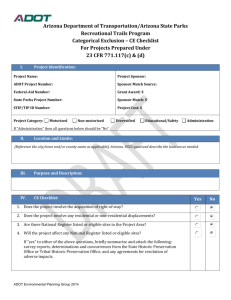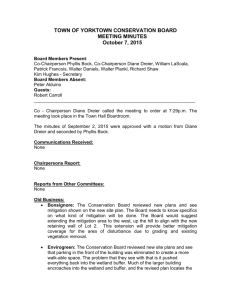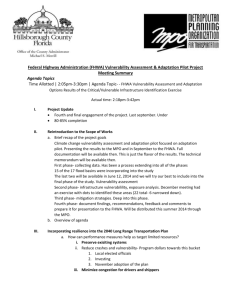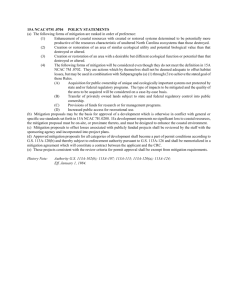For Railroad Projects
advertisement
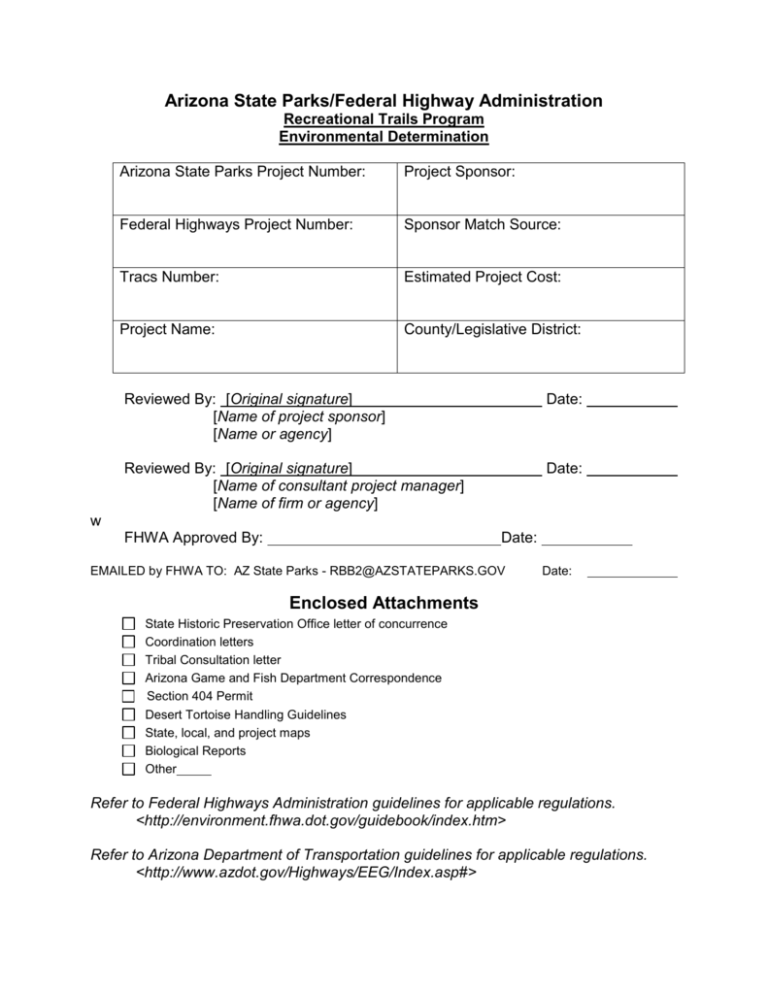
Arizona State Parks/Federal Highway Administration Recreational Trails Program Environmental Determination Arizona State Parks Project Number: Project Sponsor: Federal Highways Project Number: Sponsor Match Source: Tracs Number: Estimated Project Cost: Project Name: County/Legislative District: Reviewed By: [Original signature] [Name of project sponsor] [Name or agency] Date: Reviewed By: [Original signature] [Name of consultant project manager] [Name of firm or agency] Date: w FHWA Approved By: Date: EMAILED by FHWA TO: AZ State Parks - RBB2@AZSTATEPARKS.GOV Date: Enclosed Attachments State Historic Preservation Office letter of concurrence Coordination letters Tribal Consultation letter Arizona Game and Fish Department Correspondence Section 404 Permit Desert Tortoise Handling Guidelines State, local, and project maps Biological Reports Other Refer to Federal Highways Administration guidelines for applicable regulations. <http://environment.fhwa.dot.gov/guidebook/index.htm> Refer to Arizona Department of Transportation guidelines for applicable regulations. <http://www.azdot.gov/Highways/EEG/Index.asp#> FHWA Project No. _______________ ASP Project No. _______________ Project Name. _______________ Project Description Existing Conditions (Attach state and vicinity maps as Figure 1, and Figure 2, respectively. Include additional maps as needed.) Description should include project need, purpose and scope of work. Land Ownership and Land Use Location MP to MP Owner agency/private Land Use designated Right-of-Way/Easements No new right(s)-of-way or easement(s) is required for construction of this project. New right(s)-of-way or easement(s) is required for construction of this project. [acreage] of new right-of-way from [acreage] of temporary easement Specific parcel(s) information: Other (ownership/jurisdiction) (construction, utility, maintenance, etc.) FHWA Project No. _______________ ASP Project No. _______________ Project Name. _______________ Land Management Authority Not present Present Comment Tribal Federal Tribe(s): Agency(ies): State Agency (ies): Impacts on the Natural Environment Sensitive Biological Resources 1. Threatened/Endangered Species 2. Federal Sensitive Species/Habitat 3. Tribal Sensitive Species/Habitat BR BR BR FHWA Project No. _______________ ASP Project No. _______________ Project Name. _______________ 4. AZ Species of Concern/ Habitat 5. Native Plants 6. Other Wildlife and Habitat Concerns Invasive Species* Section 404 Waters of the US Section 401 Wetland Areas Riparian Areas Visual Resources Prime or Unique Farmlands Section 4(f) Resources (wildlife refuge) BR Date of survey: Agency commenting and date of comment: Name and organization and date of survey: Permit type and number: Certification type: NRCS map section: Impacts on Cultural Resources Archaeological/Historic Resources Section 4(f) Resources (cultural) Report and concurrence date: Impacts on Socioeconomic Resources Not Applicable Applicable Residential Property(s) Affected Commercial Property(s) Affected Temporary/Permanent Access Section 4(f) Resources (recreation) Physical/Construction Impacts AZPDES/NPDES Other FHWA Project No. _______________ ASP Project No. _______________ Project Name. _______________ Public Involvement Date contacted Method of notification Comment Agency Coordination (as applicable) Bureau of Indian Affairs Bureau of Land Management Bureau of Reclamation Environmental Protection Agency US Army Corps of Engineers US Coast Guard US Fish and Wildlife Service USDA Forest Service National Park Service State Historic Preservation Office Tribal Historic Preservation Office Arizona Fish and Game Department Department of Public Safety County Local Municipality Other Public Meeting(s) Public meeting was not required. [Explain:] Public meeting(s) was (were) held. Date(s) and location(s). Number of attendees. Method(s) of notification. Handout materials. No Yes—see attached Comments [summarize]. Responses [summarize]. Response FHWA Project No. _______________ ASP Project No. _______________ Project Name. _______________ Sensitive Biological Resources 1. Threatened and Endangered Species A BR, BE or a BA&E was prepared, and an effects determination made for each species. [Include name of report and date of approval by ADOT.] The project will not affect listed, threatened, endangered, proposed, or candidate species or designated critical habitat. 1. Species given a detailed analysis: 2. No affect because: The project may affect but is not likely to adversely affect listed, threatened, endangered, proposed, or candidate species or designated critical habitat. 1. Species name[s] with a may affect: 2. Justification of species with a may affect. 3. Required mitigation measures. 4. Date of USFWS concurrence letter. 5. Statement of no affect to other species. The project may affect and is likely to adversely affect listed, threatened, endangered, proposed, or candidate species or designated critical habitat. 1. Species name[s] with a may affect: 2. Justification of species with a may affect. 3. Required mitigation measures. 4. Date of USFWS concurrence letter. 5. Statement of no affect to other species. 2. Federal Sensitive Species Coordination with [land managing agency] has been completed. [Describe mitigation required to protect the sensitive species.] Sensitive species on the land managing agency’s list were analyzed in the BE/BA&E. 1. Date species list received from agency [attach species list(s)]. 2. Species with detailed analysis and determination. 3. Required mitigation measures. 4. Date of land managing agency review: Land managing agency declined to review but a courtesy copy of the document was submitted. 3. Tribal Sensitive Species The project occurs on [name of Tribe] tribal lands. If White Mountain Apache tribal land, the Tribe completes the surveys and biological reports. 1. Species of tribal concern that were analyzed: 2. Anticipated effects on the analyzed species. 3. Required mitigation measures. 4. Date of tribal review: FHWA Project No. _______________ ASP Project No. _______________ Project Name. _______________ The Tribe declined to review the document. 4. Arizona Species of Concern (Arizona Game and Fish Department) AGFD Coordination. 1.AGFD sent a Sensitive Species list. 2.AGFD did not respond or did not respond with a Sensitive Species list. Sensitive species 1. Sensitive species AGFD requested specific consideration for, or species that ADOT has determined a need to address: [List the species.] 2. Mitigation measures. 5. Native Plants (Arizona Department of Agriculture’s list of protected native plants) <http://www.azda.gov/ESD/nativeplants.htm> There are existing protected native plants within the project limits that will not be impacted. [List applicable mitigation.] Native plants impacts. There are existing protected native plants on federal lands in the project limits that will be impacted. The Arizona Department of Agriculture has no jurisdiction on federal lands. [Discuss the appropriate land-managing agency’s requirements (Bureau of Land Management, National Forest, tribal lands).] Protected native plants within the construction limits will be impacted by the project; therefore, the ADOT Roadside Development Section will notify the Arizona Department of Agriculture at least 60 days prior to the start of construction to afford commercial salvagers the opportunity to remove and salvage these plants. 6. Other Wildlife and Habitat Concerns Riparian Wetland Game Species Recreation Impacts Wildlife connectivity Other Comment from agency. [State the agency and the date the comment was received and attach.] Mitigation Measures FHWA Project No. _______________ ASP Project No. _______________ Project Name. _______________ Invasive Species (Executive Order 13112, dated February 3, 1999) Invasive species occur. List the species: These species are treated according to an invasive species management plan, and any necessary treatments will continue following completion of construction. Mitigation Measures [Include applicable mitigation from the Natural Resources Management Section report.] Design Responsibilities [for all projects] All disturbed soils that will not be landscaped or otherwise permanently stabilized by construction will be seeded using species native to the project vicinity. Contractor Responsibilities [for all projects] All earthmoving and hauling equipment shall be washed at the contractor’s storage facility prior to arriving on-site to prevent the introduction of invasive species seed. All disturbed soils that will not be landscaped or otherwise permanently stabilized by construction shall be seeded using species native to the project vicinity. Contractor Responsibilities [for ADOT projects with invasive species on site] All earthmoving and hauling equipment shall be washed prior to leaving the construction site to prevent invasive species seeds from leaving the site. For Railroad Projects [This applies to railroad projects that do not meet the criteria of the railroad crossing condensed clearance memo.] [When invasive species have been reported by the consultant for a railroad project, use the following mitigation measures]: In compliance with Executive Order 13112 regarding invasive species, all earthmoving and hauling equipment shall be washed prior to leaving the construction site to prevent invasive species seeds from leaving the site. During an invasive species survey, [list invasive specie(s) found in the project area] was (were) found in the project area. Prior to project commencement, these species shall be treated by qualified personnel using an appropriate technique. Note: The ADOT consultant will do the invasive species surveys for railroad projects. When invasive species are found within the project area on railroad projects, include the invasive species report as an attachment to the clearance document and clearance memo. Make sure the invasive species report includes a physical description of the invasive species found and the location. FHWA Project No. _______________ ASP Project No. _______________ Project Name. _______________ Clean Water Act Compliance Section 404 Permit Fill or dredged material will be placed in waters of the United States. Area of disturbance within waters of the US [acres, cubic yards, linear feet]. Nationwide Section 404 Permit from the US Army Corps of Engineers (Corps) required. [Attach permit, applicable General Conditions, and Regional Conditions.] Nationwide Permit (NWP) No. Without a Preconstruction Notification (PCN). With a Preconstruction Notification. Corps has made this determination on [date]. The Memorandum of Understanding between USFWS and the Corps dated March 2003 on the cactus ferruginous pygmy owl applies. [Discuss.] Individual Section 404 Permit required. The project is state-funded, and an individual permit is required. [Coordinate with the ADOT EEG NEPA planner.] The project is federally funded and an individual permit is required. [The NEPA/404 Memorandum of Understanding (MOU) implemented in 1993/94 must be followed.] Section 401 Water Quality Certification Certified Conditionally Certified Individually Certified Project on non-tribal lands. Section 401 Water Quality Certification is authorized by ADEQ (602.771.4502) Project on tribal lands, except the Fort Apache Indian Reservation. Section 401 Water Quality Certification is authorized by the EPA. [Contact Environmental Protection Agency, Mail Code WTR 8, 75 Hawthorn Street, San Francisco, CA 94105.] Project on the Fort Apache Indian Reservation. The Section 401 Water Quality Certification is authorized by the White Mountain Apache Tribe. [928.338.2479] Mitigation Measures FHWA Project No. _______________ ASP Project No. _______________ Project Name. _______________ 1. Section 404 Nationwide Permits Without Preconstruction Notification [Use the following mitigation measures, and edit as appropriate:] Contractor Responsibilities The contractor shall comply with all terms and conditions of the attached Section 404 Nationwide Permit No. [insert permit number], as established by the US Army Corps of Engineers. The terms and General Conditions include, but are not limited to, the following: [List the applicable Section 404 General and Regional Conditions. Do not number the conditions; rather, use bullets. Change “permittee” to “contractor.” Use bold face type for the title of the General Condition.] 2. Section 404 Nationwide Permits With Preconstruction Notification or Individual Permit Contractor Responsibilities The contractor shall comply with all terms, General and Special Conditions of the attached US Army Corps of Engineers’ Section 404 Nationwide/Individual (select) Permit No. [insert permit number here or omit if individual permit]. The terms, General, and Special Conditions include, but are not limited to, the following: [List the applicable Section 404 General and all Special Conditions. Do not number the conditions; rather, use bullets. Change “permittee” or “applicant” to “contractor.” Make sure the title of the General and Special Conditions are in bold face type.] 3. Section 401 Water Quality Certification [Begin listing the applicable Section 401 conditions here. If an individual Section 401 Certification was issued, include all conditions. Do not number the conditions; rather, use bullets.] Conditional 401 Certification Individual 401 Certification FHWA Project No. _______________ ASP Project No. _______________ Project Name. _______________ Wetland Areas There are wetland areas within the project vicinity that will not be impacted because these areas will be avoided by construction. [Include necessary mitigation measures.] There are wetland areas that will be impacted by the project. 1. Proposed work in the wetland[s] [e.g., excavation, fill, marsh disposal]. 2. Location of wetland[s] affected by the proposal. [Include wetland name(s), if available. Use maps, sketches, plans showing where wetlands will be impacted, or other graphic aids.] 3.Observed or expected waterfowl and wildlife inhabiting or dependent on the wetland. [List should include both permanent and seasonal residents.] 4. FHWA Wetland Policy (23 CFR § 777) Not applicable [explain]. Individual Wetland Finding required [summarize why there are no practicable alternatives to the use of the wetland]. 5. Erosion control or storm water management measures that will be used to protect the wetland. Control measures [briefly describe control measures to be used]. None will be used. 6. Section 404 Permit: See attached Clean Water Act Compliance sheet. 7. Wetland mitigation [state avoidance, minimization, or mitigation as required]. The project has been coordinated with the Corps, and there have been no substantial concerns expressed over the proposed use of the wetlands. Mitigation Measures FHWA Project No. _______________ ASP Project No. _______________ Project Name. _______________ Riparian Areas There are riparian areas within the project vicinity that will not be impacted because these areas will be avoided by construction. [Include necessary mitigation measures.] There are riparian areas that will be impacted by the project. Note: Contact the ADOT EEG NEPA planner for guidance. 1. Proposed work in the riparian area[s] [describe, e.g., excavation, fill]. 2. Location of the riparian area[s] affected by the proposal. [Describe and include watercourse name(s), if available. Use maps, sketches, plans showing where riparian area(s) will be impacted, or other graphic aids.] 3. Observed or expected wildlife and plants inhabiting or dependent upon the riparian area[s]. [List should include both permanent and seasonal residents.] 4. FHWA Wetland Policy (23 CFR § 777) Not applicable [explain] Individual Wetland Finding required [summarize why there are no practicable alternatives to the use of the wetland]. 5. Erosion control or storm water management measures that will be used to protect the riparian area are shown on the Arizona Pollutant Discharge Elimination System sheet: Yes No [briefly describe measures to be used] 6. Section 404 Permit: see attached Clean Water Act Compliance sheet. 7. Riparian mitigation [state avoidance, minimization, or mitigation as required]. The project has been coordinated with AGFD and there have been no substantial concerns expressed over the proposed use of the riparian area[s]. Mitigation Measures Contractor Responsibilities The contractor shall submit the [Arizona Pollutant Discharge Elimination System or National Pollutant Discharge Elimination System—select the appropriate one] Notice of Intent and the Notice of Termination to the [Arizona Department of Environmental Quality or Environmental Protection Agency—select the appropriate one]. For railroad projects: Because the project is federally funded, the [applicable railroad company], in accordance with 23 CFR § 650, Subpart B, shall determine whether design features to reduce erosion and minimize sedimentation during and after construction are required. FHWA Project No. _______________ ASP Project No. _______________ Project Name. _______________ Visual Resources There is a change in the existing visual character as a result of the project. Note: Describe the existing visual character using the methodology outlined in FHWA’s Visual Impact Assessment for Highway Projects (March 1981). Include a discussion of the visual elements in the landscape such as prominent landforms, landmarks, land use patterns, vegetation, development architectural character and density, and water features, as appropriate, that are located in the foreground. Distant view of landforms and/or landmarks may also be noted. Discuss the magnitude (“notable,” “substantial,” or “severe”) of any change in the visual character as a result of the project. The project is on an easement from a land managing agency with specific management goals. [Include a brief description of the agency’s resource management objectives and state whether or not the objective is achieved. Contact the land managing agency for concurrence.] Mitigation measures are needed to avoid or minimize negative scenic effects in the landscape. [List mitigation.] Mitigation Measures FHWA Project No. _______________ ASP Project No. _______________ Project Name. _______________ Prime or Unique Farmlands (Farmland Protection Policy Act [7 USC § 4202, Rules, and 7 CFR § 658]) Note: Contact the Natural Resources Conservation Service to determine whether the farmland is prime or unique, and the appropriate state or local agency to determine whether it has statewide or local importance. 1. Presence of farmland: Within the project area. Adjacent to the project area. 2. Type of farmland: importance prime unique statewide importance local 3. Farmlands impacted by project. No Yes [Describe the impacts.] Number of acres removed from farming. Number of farms operations from which land will be acquired. 4. Federally funded projects [select from the following]: There is farmland adjacent to the project area, but all construction activities will be within the existing right-of-way. The farmland adjacent to the project area has already been in, or committed to, urban development or water storage. Prime or unique farmland will be impacted. [Process the Natural Resources Conservation Service’s Farmland Conversion Impact Rating form and attach.] Prime or unique farmland will be impacted in a corridor-type project. [Process the Natural Resources Conservation Service’s Farmland Conversion Impact Rating Form for Corridor Type Projects and attach.] 5. For state-funded projects for farmland of statewide or local importance, coordination with the state or local agency [select appropriate one and describe the coordination]. Mitigation Measures FHWA Project No. _______________ ASP Project No. _______________ Project Name. _______________ Archaeological Resources and Historic Properties 1. Survey Data Survey data. [Provide information on if, when, and where surveys were conducted and reference the report(s).] 2. Archaeological/Historical Sites No sites present. Known archaeological/historical sites occur in the project limits. [List number of sites.] Description of sites present [DO NOT list milepost locations of specific sites.]. 3. Agency/State Historic Preservation Office Determination Agency/State Historic Preservation Office (SHPO) determination of eligibility and effect. Signatories to concurrence agreements [list]. Eligible for inclusion in the National Register of Historic Places (NRHP) is based on the following criteria: Criterion A: significant themes in our nation’s history Criterion B: significant persons in our nation’s history Criterion C: embody distinctive construction characteristics or works of a master Criterion D: have the potential to contribute information significant to history or prehistory Listed in ARHP/NRHP Criterion: A B C D Eligible Criterion: A B C D Eligibility not determined Criterion: A B C D Ineligible Agency determination of effect [select one]: No effect No adverse effect Adverse effect No potential to effect Agency concurrence date[s]: SHPO THPO/Tribe [list Tribe(s)] USDA FS BLM Reclamation ASLD Other [Discuss testing, data recovery, additional documentation, flagging/avoidance, and monitoring, as Mitigation Measures applicable.] If previously unidentified cultural resources are encountered during activity related to the construction of the project, the contractor shall stop work immediately at that location and shall take all reasonable steps to secure the preservation of those resources. The ADOT Engineer will contact the ADOT Environmental & Enhancement Group, Historic Preservation Team, at 602.712.8636, immediately and make arrangements for proper treatment of those resources. [For railroad projects, add:] If previously unidentified cultural resources are identified during construction, work will cease at that location and the ______________ [applicable railroad company] will arrange for proper treatment of these resources. FHWA Project No. _______________ ASP Project No. _______________ Project Name. _______________ Section 4(f) Resources (federally funded project only) [Section 4(f), of the US Department of Transportation Act of 1966 (as amended and recodified in 1983); 49 USC 303(c); and 23 CFR § 771.135(p)] Note: If there is any Section 4(f) use, a Categorical Exclusion is nonprogrammatic and must be signed by FHWA. There is a Section 4(f) resource in the project area, but there is no Section 4(f) involvement [discuss]. There is Section 4(f) involvement [follow the FHWA 4(f) policy paper and 23 CFR 771.135(p)]. Type: public park[s] recreational land[s] wildlife and waterfowl refuge(s) independent bikeway or walkway] historic bridge historic site[s The project uses enhancement funds for the restoration, rehabilitation, or maintenance of a historic resource. The project uses enhancement funds for independent bikeway or walkway construction projects. [Conduct analysis in accordance with the FHWA memorandum dated May 23, 1977, “Negative Declaration/Section 4(f) Statement for Independent Bikeway or Walkway Construction Projects.”] 1. A “use” of a Section 4(f) resource, as defined in 23 CFR §771.135(p), occurs: 1) when land is permanently incorporated into a transportation facility; 2) when there is a temporary occupancy of land that is adverse in terms of the statute’s preservationist purposes; or 3) when there is a constructive use of land. A constructive use of a Section 4(f) resource occurs when the transportation project does not incorporate land from resources, but the project’s proximity impacts are so severe that the protected activities, features, or attributes that qualify a resource for protection under Section 4(f) are substantially impaired. For example, a constructive use can occur when: a) the projected noise level increase, attributable to the project, substantially interferes with the use and enjoyment of a noise-sensitive facility of a resource protected by Section 4(f); b) the proximity of the proposed project substantially impairs aesthetic features or attributes of a resource protected by Section 4(f), where such features or attributes are considered important contributing elements to the value of the resource. An example of such an effect would be the location of a proposed transportation facility in such proximity that it obstructs or eliminates the primary views of an architecturally significant historical building, or substantially detracts from the setting of a park or historic site which derives its value in substantial part due to its setting; and / or c) the project results in a restriction on access, which substantially diminishes the utility of a significant publicly-owned park, recreation area, or historic site. Describe any effects on or uses of land from the property. [For historic and archeological sites, give the results or status of Section 106 coordination. For other Section 4(f) areas, include or attach statements from officials having jurisdiction over the property that discusses the project effects on the property. A map, sketch, plan, or other graphic, which clearly illustrates use of the property and the project’s use and effects on the property, must be included.] Mitigation Measures FHWA Project No. _______________ ASP Project No. _______________ Project Name. _______________ Socioeconomic Resources 1. Residential Property[s] Affected a. Residential displacements. No Yes. Number of displacements . b. Known planned development[s] [describe]. 2. Commercial Property(s) Affected a. Commercial displacements. No Yes. Number of displacements . b. Known planned development[s] [describe]. 3. Temporary and Permanent Access Impacts could include nonvehicular access, such as for pedestrians, and impacts to special events, such as fairs and parades. a. Temporary impacts: business disruption access change parking restrictions other: b. Permanent impacts business disruption access change parking restrictions other: c. Temporary impacts to residential neighborhoods [or individual residents or both—address appropriate ones.] d. Permanent impacts to residential neighborhoods [or individual residents or both—address appropriate ones.] e. Temporary changes in traffic service or patterns as a result of the project. [Address.] Temporary access restrictions/changes. [Discuss.] f. Permanent changes in traffic service or patterns as a result of the project. [Address.] Permanent access restrictions/changes. [Discuss.] Mitigation Measures FHWA Project No. _______________ ASP Project No. _______________ Project Name. _______________ Arizona Pollutant Discharge Elimination System/ National Pollutant Discharge Elimination System The project involves the disturbance of 1 or more acres and an AZPDES or NPDES general permit will be required. [NPDES applies only on tribal lands.] There is an impaired or unique water within 0.25 miles of the project. This is a railroad project. Mitigation Measures Design Responsibilities The Arizona Department of Transportation Roadside Development Section will determine who will prepare the Stormwater Pollution Prevention Plan. District Construction Responsibilities The District Construction office will submit the (Arizona Pollutant Discharge Elimination System or National Pollutant Discharge Elimination System) Notice of Intent and the Notice of Termination to the [Arizona Department of Environmental Quality or Environmental Protection Agency—select the appropriate one]. For Railroad Projects: Because this project is federally funded, the ___ (applicable railroad company), in accordance with “Title 23, Code of Federal Regulations, Part 650, Subpart B,” shall determine if design features to reduce erosion and minimize sedimentation are required during and/or after construction. FHWA Project No. _______________ ASP Project No. _______________ Project Name. _______________ Mitigation Measures Note: For All Documents Mitigation is provided on each of the resource sheets and collectively on this page and in the clearance memo. The ADOT EEG NEPA planner will coordinate mitigation with the appropriate ADOT EEG staff and ADOT District(s) prior to submittal of the draft and final environmental documents. Include specific mitigation measures. Separate the mitigation measures as follows: Design Responsibilities District Construction Responsibilities Contractor Responsibilities Any other applicable categories Use the word “attached” for any enclosures that will be included in the special provisions for the project: e.g., the attached NWP No.14. Use the word “will” when referring to ADOT personnel’s responsibilities and the word “shall” when the contractor is to perform a function. Project Mitigation: If previously unidentified cultural resources are encountered during activity related to the construction of the project, the contractor shall stop work immediately at that location and shall take all reasonable steps to secure the preservation of those resources. The ADOT Engineer will contact the ADOT Environmental & Enhancement Group, Historic Preservation Team, at 602.712.8636, immediately and make arrangements for proper treatment of those resources. For Railroad Projects: If previously unidentified cultural resources are identified during construction, work will cease at that location and the _________________ (applicable railroad company) will arrange for proper treatment of the resources. FHWA Project No. _______________ ASP Project No. _______________ Project Name. _______________ Relevant Legislation, Regulations, or Executive Orders Invasive Species Executive Order 13112, dated February 3, 1999 100-Year Floodplain and Impacts 23 CFR § 650, Subpart A (Title 23 Code of Federal Regulations, Part 650, Subpart A) Clean Water Act Compliance Section 404 Permit 2002 Nationwide Permits, January 15, 2003, 67 CFR § 2020; Corrections to 2002 Nationwide Permits, February 13, 2002, 67 CFR § 6692 and February 25, 2002, 67 CFR 8579; Nationwide Permit General Conditions, 33 CFR 325, 330; Special Public Notice, Nationwide Permits for Arizona, US Army Corps of Engineers, Regional Conditions for the Los Angeles District, Arizona Section, April 19, 2002 and Nationwide Permits 6, 12, 14, 18, 39, and 43. Prime or Unique Farmlands Farmland Protection Policy Act (7 USC § 4202, Rules, and 7 CFR § 658) Sole Source Aquifers Safe Drinking Water Act of 1974, § 1424(e) Section 4(f) Resources Section 4(f), of the US Department of Transportation Act of 1966 (as amended and recodified in 1983); 49 USC 303(c); and 23 CFR § 771.135(p) Title VI/Environmental Justice Executive Order 12898 and EEG Environmental Justice Guidance Noise Abatement 23 CFR § 772 Air Quality 40 CFR § 51.460 and 40 CFR § 51.462; Arizona conformity rules “R-18-2-1434” and “R-18-2-1435,” respectively
